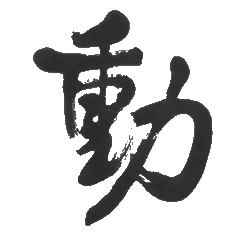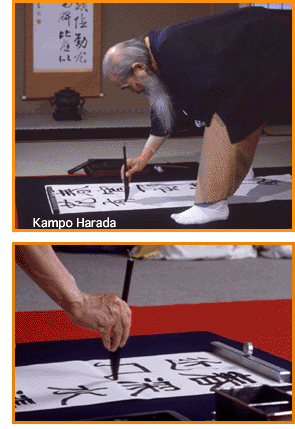Shodo
 Shodo is the Japanese word for "calligraphy" or "penmanship." Sho means "writing" and do means a "way or path." In China and Japan, Shodo is not merely the exercise in good handwriting, but has long been regarded as one of the most important forms of art in the Far East.
Shodo is the Japanese word for "calligraphy" or "penmanship." Sho means "writing" and do means a "way or path." In China and Japan, Shodo is not merely the exercise in good handwriting, but has long been regarded as one of the most important forms of art in the Far East.
Most languages of the world use phonetic symbols, but except for the earliest languages there are hardly any that use hieroglyphs, pictographs or ideographs as the basis for their written languages. Languages using phonetic symbols need relatively few symbols to fulfill their communicative purposes: it is this need for only few symbols that represents the strength of such systems. However, in China, as well as in Japan, the written language is based on direct visual representation.
At the simplest level of vocabulary, each written word is actually a picture of the object it describes.
There are about two hundred of these elemental ideographs for common objects. They are  the foundation of the forty thousand and more Chinese and Japanese characters. Until the 20th century, writing in the East was done with a brush dipped in ground ink. With the supple brush, the elegantly complex characters, and the proper frame of mind, every piece of writing becomes an act of profound expression.
the foundation of the forty thousand and more Chinese and Japanese characters. Until the 20th century, writing in the East was done with a brush dipped in ground ink. With the supple brush, the elegantly complex characters, and the proper frame of mind, every piece of writing becomes an act of profound expression.
Oriental calligraphy is the dynamic execution of lines in vast range of rhythmic combinations. The infinitely variable balance of the successive strokes, the flow and the tension, the strength and the proportion of each character are the unique product of the form, writer's personality, and the moment. Through Shodo, the language, the eye, and the hand are linked to the deeper sources of consciousness.
In the West calligraphy, "a beautiful hand" was supposed to suppress eccentricities in style. Shodo, on the other hand, attempt to bring words to life, to actually endow them with "character." The characters given in the text have been especially chosen to illustrate these various lines and to develop the artists ability with the brush.

There are five basic styles of Chinese scripts that were developed during different dynasties. Old styles are "tensho" and "reisho" and they proceeded to evolve into a new script which they called "kaisho" standard script. Two other script styles that followed were "gyosho" semi-cursive and "sosho" full-cursive script which is called "grass" script, comparable to Western shorthand and just as difficult to read. In Japanese language, besides using these five style characters which are called "kanji," there is another script, "hiragana," which evolved from "sosho" characters.
 Shodo is the Japanese word for "calligraphy" or "penmanship." Sho means "writing" and do means a "way or path." In China and Japan, Shodo is not merely the exercise in good handwriting, but has long been regarded as one of the most important forms of art in the Far East.
Shodo is the Japanese word for "calligraphy" or "penmanship." Sho means "writing" and do means a "way or path." In China and Japan, Shodo is not merely the exercise in good handwriting, but has long been regarded as one of the most important forms of art in the Far East.  the foundation of the forty thousand and more Chinese and Japanese characters. Until the 20th century, writing in the East was done with a brush dipped in ground ink. With the supple brush, the elegantly complex characters, and the proper frame of mind, every piece of writing becomes an act of profound expression.
the foundation of the forty thousand and more Chinese and Japanese characters. Until the 20th century, writing in the East was done with a brush dipped in ground ink. With the supple brush, the elegantly complex characters, and the proper frame of mind, every piece of writing becomes an act of profound expression.